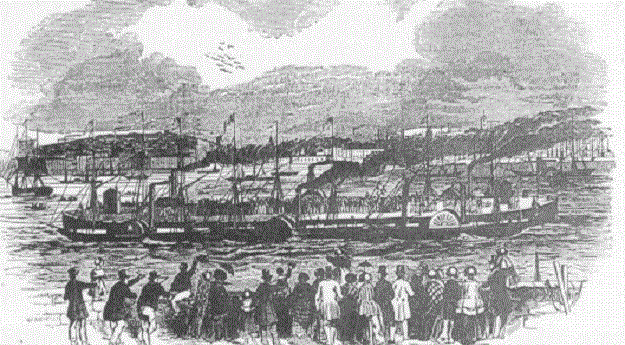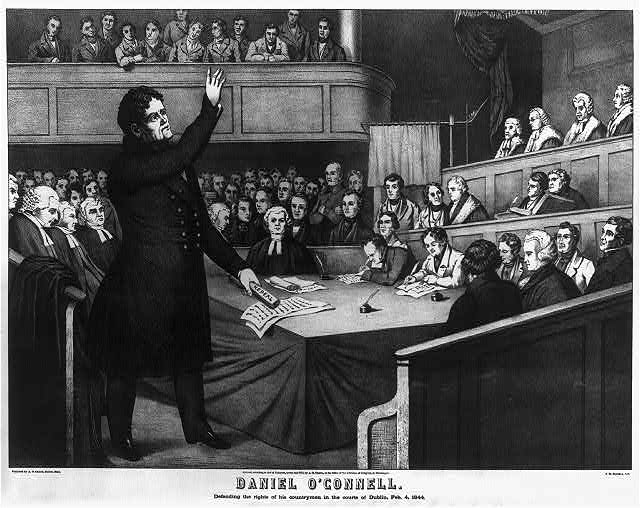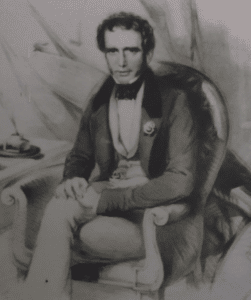In 1847, landlord Major Denis Mahon of the Strokestown Park estate in county Roscommon realised that it would be significantly cheaper to send his indebted and starving tenants to North America than to continue providing them with food. So he set up an assisted emigration scheme to clear some of his 12,000 tenants.
1,490 tenants from 274 families signed up for the long and precarious journey to Quebec.
A three month trek
In May of 1847, these tenants left their neglected cottages and gathered together in Strokestown village at the gates of the big manor house, which still stands there today. The first hurdle of their journey would be a 165km walk to Dublin’s docklands.
To Dublin
Led by a bailiff, the walk took them along the Royal Canal through counties Longford, Westmeath, Meath, Kildare and Dublin. Early on in their journey, they passed the ticket house which sold passage to Dublin by boat. But they continued walking as their landlord hadn’t included this as part of the scheme.
The tenants would have been passed out by barges full of porter and whiskey also destined for Dublin, while grain and other provisions would have been en route to breweries and distilleries along the canal – many of which continued to thrive during the famine.
According to research from the National Famine Way, three months earlier, Daniel O’Connell had stood up in parliament and called for the industry’s production to be put on hold and for its grain to be given to famine sufferers. But his pleas fell on deaf ears. He died that May – just before the 1,490 tenants of Strokestown began their exodus to Dublin.
In Westmeath, some of the biggest losses of the famine occurred in Castletown and Killare. According to local historian Seamus O’Brien, these two towns lost 53% and 40% of their populations, respectively, to death and emigration between 1841 and 1851. The group then passed through Mullingar. For many of the children, it may have been their first time visiting a large town. It was home to one of the country’s largest workhouses, so they would have seen starving men and women in rags, as well as some of the thousands of men who built the train lines there at that time.
The journey to Dublin took four days altogether and the tenants slept rough along the canal each night. When they finally reached Dublin, the land agent provided them with prepaid passage for Liverpool and Quebec.
To Liverpool
The boat to Liverpool took less than a day. But the difficulties began upon their arrival. Here, in Europe’s busiest port, scammers were ready to take advantage of even the most destitute migrants.
Disease was also a problem. Typhus had reached epidemic proportions in Liverpool in May 1847 and many of the tenants stayed at lodgings in the city before their departure.
However, it’s worth noting that some of the Strokestown tenants sold their tickets to Quebec while staying in Liverpool.
To Quebec
To reduce the number of dying and disease-ridden emigrants arriving at their ports, the US had introduced a series of Passenger Acts, which aimed to minimise disease by improving the conditions on board ships. However, this also made the cost of passage to the US more expensive.
On the other hand, the British Government retained its lower standards and so, in 1847, there was a massive influx of migrants arriving in Canada. This is where Mahon sent his tenants.
The tenants of Strokestown left Liverpool on four ships: The John Munn, Erin’s Queen, the Naomi and the Virginius. It is certain that at least three of these cargo ships had unsanitary conditions and inadequate supplies, according to Professor Mark McGowan from the University of Toronto.
He also highlights how, across the four ships, a third of household heads and a quarter of all passengers died during the sailing. Their bodies were wrapped in sacks or old sails and unceremoniously thrown overboard.
To quarantine
After almost two months at sea, the surviving tenants still had one last hurdle to overcome. Knowing that the coffin ships carried disease, the Canadian authorities had set up a quarantine station at Grosse Île – an island on the St. Lawrence river.
In 1847, as increasing numbers of Irish emigrants headed for Quebec, the island was inundated with arrivals. Staff there requested extra resources from the British authorities, but received little assistance. By June 1847, around the time the Strokestown tenants arrived, a mile long queue of ships had formed.
After 63 days at sea, passengers aboard the Virginius waited another 13 days before being able to disembark. Of the 476 people aboard, 158 had died during the passage – some died before the boat had even left the dock in Liverpool. Another 19 died while queuing along the St. Lawrence river. Then of the 106 who were ill upon arrival, 90 died at the quarantine hospital. In total, well over half the passengers passed away.
In a report for the British parliament, Dr. George Douglas, the medical superintendent on Grosse-Île at that time, described the Strokestown’s emigrants aboard the Virginius:
“The few that were able to come on deck were ghastly yellow looking spectres, unshaven and hollow cheeked, and, without exception, the worst looking passengers I have ever seen; not more than six or eight were really healthy and able to exert themselves.”
The tenants on the three other ships fared slightly better with shorter journey times and less deaths. However, they all lost well over 100 people.
The aftermath of the scheme
Back in Strokestown, Major Denis Mahon didn’t face any immediate backlash. But by the end of the summer, relations with his remaining tenants had soured. Food prices were rising, news about the fate of the 1,490 trickled homeward and even a local priest denounced his actions.
By autumn, a murder plan had been hatched and, on November 2nd, Mahon was shot dead as he returned home from a meeting where he sought relief for his tenants.
As for the tenants who reached Quebec’s mainland, many of their stories remain a mystery. However, the National Famine Museum at Strokestown and Professor Mark McGowan at the University of Toronto have led efforts to figure out what happened to them.
They have traced some of the survivors to Irish Street in Montreal and to the Niagara region of Ontario. They also unearthed the stories of James Flood and Daniel Tighe – who both became orphans by the time they arrived in Quebec. In fact, it is Tighe’s experiences that provide the inspiration for the National Famine Way along the Royal Canal.
The National Famine Way allows walkers to follow the path of the 1,490 tenants from Strokestown Park Estate in county Roscommon to the Jeanie Johnston famine ship in Dublin’s docklands. Order a Famine Way pack or search your app store for the Famine Way App to take part.



